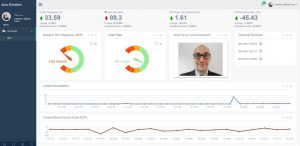Most purchases are driven by our emotions as the consumer's emotional experience is crucial in buying choices. And so we decided to exert the powerful SAS algorithms on a dashboard born in the beginning as a simulation of a remote control system in the healthcare field for home-based patients. The development of this application utilizes a set of five parameters (Heartbeat, Blood Flow Volume, Acceleration, Temperature and Galvanic Skin Response) as a practical demonstration of emotional state analysis. Emotion is the matrix of all the KPIs and emotions pass literally through our skin with the electrical variations transmitted by the nerves and the sweat of the skin.
During SAS Forum Milan 2017, I was interviewed by Alberto Maestri for Ninja Marketing. Below the answers to the interview.
Analytics and emotions: is it possible?
Yes, it is possible. However, this is of course a demonstration. Emotion analysis is not the answer to everything, but a provocation of what analytical models can achieve. In other words, the idea we want to convey is that the application of other types of analytical models is certainly possible if we have even able to recognize emotion.
How did the model design concept that makes emotion recognition possible in real-time born?
The idea was born from the desire to bring tangible prototypes to customers and partners over the more classic and traditional materials in order to answer the question that anyone puts on: how do things really work, beyond slides?
We then started working on different prototypes, including this related to a wearable device. We have thus created an infrastructure that collects streaming data from a wearable, which are subsequently processed either by deterministic calculations or by applying analytic models. The SAS solution receives 104 measures per second, applies several actions (data cleaning, filtering, etc.) and are integrated with other exogenous factors when needed. It is as if the data itself already hid emotions, but only thanks to a model capable of finding hidden patterns it is possible to recognize them.
We then developed a user-friendly dashboard that shows real-time outputs, recognizing positive or negative emotion over what the subject is experiencing.

Regardless of the emotions example, how does the background model work?
There is an infrastructure that collects physiological measures through a connected device, integrating them eventually with additional external factors. SAS collects data, processes information both deterministically and analytically and makes them available in an easily understandable format to the final decision maker. Value added is on analytics: only in this way can you provide personalized services, therefore highly relevant to those who will benefit.
What are the potential areas of application of such an innovation?
First, in retail: a user enters a store, his data is collected through the wearable (or any other device capable of recording events and sending physiological measurements) and analyzed through SAS including any external sources; the emotion towards the specific product is finally read and acknowledged and an ad hoc offer is offered. Beyond the commercial aspect, such dynamics also make it possible to make a review of the product. For example, I might notice that a showcase bag has a particular color that raises a negative emotion to 93% of women. I could also re-position the same product: I try to understand what are the products that generate more positive emotions, moving them to the showcase.
Another interesting field of application is education: such solutions allow to understand and act on the learning curve steepness of individuals.
Still, the banking sphere could gain real benefits: if a person who is withdrawing money from an ATM is victim of a robbery and the device recognizes a high index of stress, it may activate punctual control systems (POS camera, etc.).
But perhaps the health sector is the most virtuous one, and this model is immediately applicable because it is capable of solving the important needs of people: there are already solutions based on emotions to generate some positive consequences such as pet or music therapies. There are systems - for example, based on images - that recognize emotions based on facial expressions, but for diseases such as multiple sclerosis it would only be possible to use the analytics proposed by our solution.
What are the peculiar and distinctive features of this solution?
- Complex math expressions can be calculated in real time.
- Execute running queries, or repeat and update the entire process each time a new data is generated, even every millisecond.
- You can perform operations such as filtering, etc. as well as view streams graphically thanks to a UI composed of blocks, each of which performs a data task (cleaning, filtering, etc.).
- It is a multi-threaded and scalable solution.
Want to read more about Analytics and IoT?
In collaboration with Industry Week, we have collected testimonials from leading companies in the United States that have told their experience and the real impact of IoT and Analytics on operating and business performance. Read more on The Internet of Things: Find the Path to Value.
